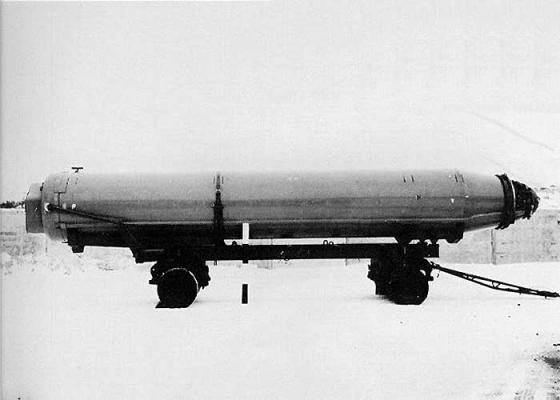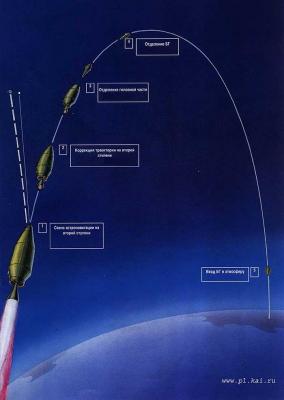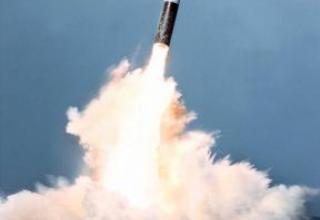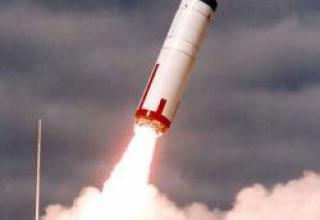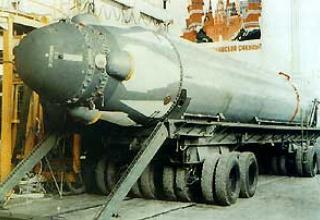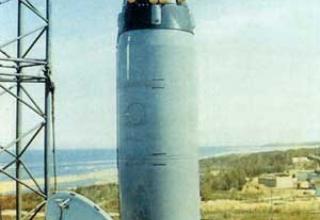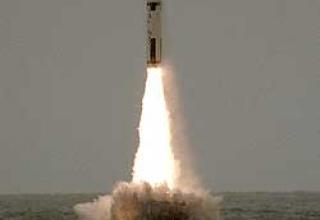The world's first sea-based intercontinental missile was the BR R-29 (DSM-40.4K-75). Its development began at the Design Bureau of V. Makeev under Resolution No. 808-33 of the Council of Ministers of September 28, 1964. Since the range of the new missile was about 8000 km, there was no need to patrol the RSSCN directly near the shores of the probable enemy, in the effective zone of its anti-submarine defense. It was envisaged the possibility of a surface launch as well, theoretically the missiles could be launched directly from the pier, without the boat going out to sea.
The first stage of testing the complex was held from a floating stand at the Black Sea experimental base of the Navy. There were 7 launches, 6 of which were successful. Then the tests were transferred to the State Central Maritime Range for missile testing by launches from the ground stand. During one of the launches, the missile exploded and the tests had to be interrupted to restore the mine and the launcher. In total, from March 1969 to November 1971 there were 20 launches from the ground stand.
The third stage of the test consisted of missile launches from a submarine. On September 22, 1964, a resolution of the Council of Ministers was issued according to which a project to upgrade the Pr.658 submarines in the Pr.701 submarine to conduct missile tests and a project to upgrade all the Pr.658 submarines to accommodate the D-9 complex were to be developed. At the end of 1964, a SLBM of Prospect 658 K-145 was allocated for re-equipment. In the course of modernization, six 4C-75-1 launchers were mounted on it. In spite of the fact that by the end of March 1971 the boat had already finished the factory tests, no rocket launches were made, as the ground tests were completed only in November of the same year. The first launch from the boat took place on December 25, 1971. As the White Sea was covered with ice, the launch was made from a surface position. During the fifth launch, a rocket exploded as it left the mine. The boat was damaged and was repaired at the Northern Machine-Building Plant, where it was located until August 3, 1972. On August 21 of the same year the sixth launch was carried out. It and like all subsequent ones, including salvo ones, was successfully launched. This stage of testing was completed on November 28, 1972, a total of 13 launches were made. December 19, 1976 K-145 upgraded on Prospect 701 became part of the Navy. It was decided not to upgrade the other PLs at 658. At the same time, according to the same SM resolution, the Malakhit Design Bureau was designing the DPLRB pr.601. The project provided for re-equipment of the PL Pr.629. by the D-9 complex. According to this project only one K-118 submarine was re-equipped and six R-29 missiles were placed on it. K-118 upgraded under the 601 project became part of the Navy on December 28, 1978. On December 27, the first SSBN Prospect 667B K-279 was added to the Navy. During the flight tests from these boats were launched 19 missiles (13 missiles from K-118 and 6 from K-279), 18 launches were considered successful. K-279 made two volleys. Four- and two-rocket. Among them, 3 missiles were launched at full range. The launches were made from the Barents Sea. The target was a firing range in the central Pacific.
According to the results of the tests, on the basis of the Council of Ministers Decree № 177-67, March 12, 1974 the D-9 missile system was adopted for service. The missiles were supposed to arm Project 667B PL (according to NATO classification - "Delta-I"). The boat of Ave. 667B carried 12 missiles against 16 on Ave. 667A SSBNs. However, despite the reduction in the number of missiles, the combat efficiency increased by 2.5 times according to experts' estimates. Until 1977, 18 SSBNs of project 667B were built.
Later on, the D-9 complex was upgraded in order to increase its range. In 1978, the D-9D complex with R-29D missiles was created. The firing range was 9,100 km. This system was installed on the 667B and 667BD submarines.
The Vysota launch vehicle was created on the basis of the RSM-40 missile capable of launching a payload of up to 115 kg into circular orbit.
In the west the complex was designated SS-N-8 "Sawfly" mod 1 and mod 2 for D-9 and D-9D, respectively.
Composition:
R-29 two-stage, monoblock missile.
Among the many problems that arose in the development of the D-9 complex, the most difficult were: the achievement of acceptable dimensions of the rocket with a significant increase in tactical and technical characteristics, the creation of fundamentally new small-size launchers and qualitatively new propulsion systems, achieving significant progress in combat units, on-board and ship control systems, automation of service, preparation of launch and multiple launch firing of the rocket set, the implementation of factory refueling of missiles with tank amputation.
The main solution, which dramatically reduced the missile's dimensions, was the introduction of a "recessed scheme" of the propulsion system - the location of engines in fuel or oxidizer tanks. It led to the reduction of the rocket's dimensions, elimination of dry compartments on the rocket to accommodate propulsion systems, the engines were created a new class: without any maintenance after manufacture, without any detachable connections and at the same time have a new higher level of energy mass characteristics. Solutions for all-welded multistage missile bodies, placement of steering drives in the fuel component, use of wafer shells, creation of permanent adapters from the engine steel elements to the aluminium casing of the missile, as well as solutions for rocking combustion chambers located in the fuel component, have yielded significant benefits. See the photo of the second stage engine.
The missile stages were separated by tearing the hull with an elongated detonation charge.
The upper bottom of the tank had a conical cavity, which housed a warhead with a 1 Mt charge. The VHF was kind of upside down in relation to the direction of flight. As a countermeasure against missile defense systems, the tank bottom of the second stage, in special cylinders, contained decoys that had an effective scattering surface (ESF) comparable to that of the BC. This solution was used for the first time in sea-based ballistic missiles. False targets were released when the head end was separated. See combat unit hull photo after test launch.
In developing a brand new hull for a small-size missile that can withstand increased overloads and excess external pressure, the prerequisites were created for designing new missile launch systems with a joint layout of the missile and the launcher.
The design of the launcher was based on fundamentally new solutions:
- instead of rigidly attaching the missile to the launch shaft, it was freely suspended in the shaft on elastic bonds with nonlinear force characteristics, and oscillations with respect to the mine were allowed during operation;
- instead of transferring point force loads to the missile through special devices, it was proposed to distribute these forces over several circular zones located at different levels along the length of the missile, using rubber-metal shock absorbers;
- instead of the direction of motion of the missile during loading and launch, using a pair of boogie guides, the inner wall of the mine or the shell of the missile itself were used for this purpose.
The total effect was very high. The ring gap and mass of the launch system were reduced by an order of magnitude, and the rocket increased accordingly almost to the size of the launch shaft itself; the huge tanks of the ring gap were reduced many times, and the filling of the ring gap ceased to limit the pre-launch preparation time, resulting in a reduced post-start imbalance of the submarine and its impact on speed.
The principle for marine missile systems was to ensure high accuracy of firing and to prepare flight missions when firing in any direction, at any time, from any point of the ocean within the reach of missiles. The peculiarity of this task is the specific requirements to the control systems for marine complexes: the launch of the missile from a movable base with non-zero initial conditions under very unfavorable dynamic characteristics of the missile as a control object. In this case, the complex must have the properties of all-weather and invariance to the launch site, as well as, within certain limits, to the accuracy of knowledge of the azimuthal direction. The control equipment should also provide practically automatic carrying out of routine checks, prelaunch preparation and launch of all missiles intended for launch (up to the complete set of the boat).
In the 1960s, attempts to solve the functions and tasks assigned to the control system with the help of analogue equipment, as well as the level of development of navigation support for submarines did not leave any hopes for their successful implementation and realization of acceptable accuracy for medium- and, moreover, intercontinental range missiles. A way out was found. This is the development and application on board the R-29 missile of precision gyroscopic devices operating in vacuum, as well as astro-correction systems (astrovizir - see photo), the transition from analog to digital analogue and then completely to digital systems with the use of high-performance small-size on-board digital computing systems and shipborne digital computing systems with special mathematical support. Introduction of trajectory correction by external reference points became a stage and priority solution for combat missiles.
As a result, the prelaunch preparation and salvo firing of a set of missiles began to be carried out centrally: by one operator from the control panel of the missile weapon, a single automated complex of control systems, including the control system itself, the ship's digital computer system, sighting system and control equipment for ship's systems of daily and prelaunch services. The start was carried out from a depth of up to 55 meters, with a sea wave of up to 8 points.
In addition to the increased efficiency and combat capabilities of the R-29 missile, another important achievement was a jump in the performance of liquid-propellant missiles. Among the many technical solutions that provide this jump, the main one is the factory refueling of the rocket, which ends in amputation of tanks by welding the filling valves. It provided a significant increase in warranty life and environmental perfection of marine missiles, as it excluded refueling operations on fleets and possible spillage of components.
Close cooperation of the developers with Zlatoust Machine-Building Plant (Director V. Zlatoustov) contributed to successful solution of technological and production problems, which allowed to develop and implement factory refueling and amputation of missiles, advanced methods of forming and machining of "wafer" shells and other case-shaped parts of missiles, argon-arc and electron-beam welding, strong-dense joints of dissimilar metals, highly effective composite materials. N. Konovalov and V. Doguzhiev), Krasnoyarsk Engineering Works (V. Kotelnikov and V. Gupalov are directors), Omsk Aviation Plant (S. Bovkun is director).
Characteristics:
| Start mass, t | 33.3 |
| Maximum mass to be thrown, kg | 1100 |
| Maximum firing range, km | 8000 (9100 for P-29D) |
| Firing accuracy at maximum range (CVO), m | 900 |
| Number of steps | 2 |
| Length, m | 13 |
| The diameter of the rocket, m | 1.8 |
Testing:
To test the D-2 complex for explosion resistance, the Central Design Bureau-16 developed a pilot compartment of the RO-629 PL with two shafts and the SM-60 launchers, R-13 missiles and D-2 complex systems located in them. During these tests in 1960, the RO-629 compartment was loaded with non-contact explosions of depth charges, mines and rope charges simulating the impact of an underwater nuclear explosion. The tests were successful and there were no comments on the need for any modifications to the SM-60 and PL facilities.
At the surrender testing of the PL Pr.629, one of the PL had two failures in the launch of missiles R-13. As later established by the Commission, the reason for this were malfunctions in the manufacture of missiles. The commander of the PL was reset one malfunctioning rocket overboard devices emergency dropping the PP, and thus, these devices have been tested in real conditions. If the commander of the PL refused to launch the second missile, it was decided to lower the missile with a lifting table in the mine and then flood the mine. Carried out then defect rocket R-13 at the manufacturing plant allowed to establish the cause of failure of the rocket at its launch.
On October 20, 1961 R-13 missile was launched with the subsequent nuclear explosion at the Novaya Zemlya test site. This is the first and only test launch of submarine ballistic missile with a nuclear explosion in the history of the country.
The D-2 missile system proved more reliable than its predecessor, the D-1. As a result of tests conducted in various, including tropical, conditions, it was possible to significantly increase the period of continuous storage of R-13 missiles on a submarine in a state of readiness. During the whole period of operation, 311 launches of R-13 missiles were conducted, of which 225 were considered successful. 38 launches proved unsuccessful due to failures of rocket systems and launch equipment, and another 38 - due to mistakes made by the personnel. The reasons for 10 unsuccessful launches were not determined.
Sources:
- www.flot.com
- Баллистическая ракета Р-29 комплекса Д-9 /Подводный флот СССР и России
- В.П. Кузин, В.И.Никольский Военно-Морской Флот СССР 1945-1991. СПб, "Историческое Морское Общество". 1996
- А.Б. Широкорад Оружие отечественного флота 1945-2000. Минск,Москва, Харвест АСТ, 2001
- Ильин В.Е., А.И. Колесников Подводные лодки России: иллюстрированный справочник. Тверь, Издательство Астрель, 2001
- Источник фото - Акционерное общество Государственный ракетный центр имени академика В.П. Макеева.
